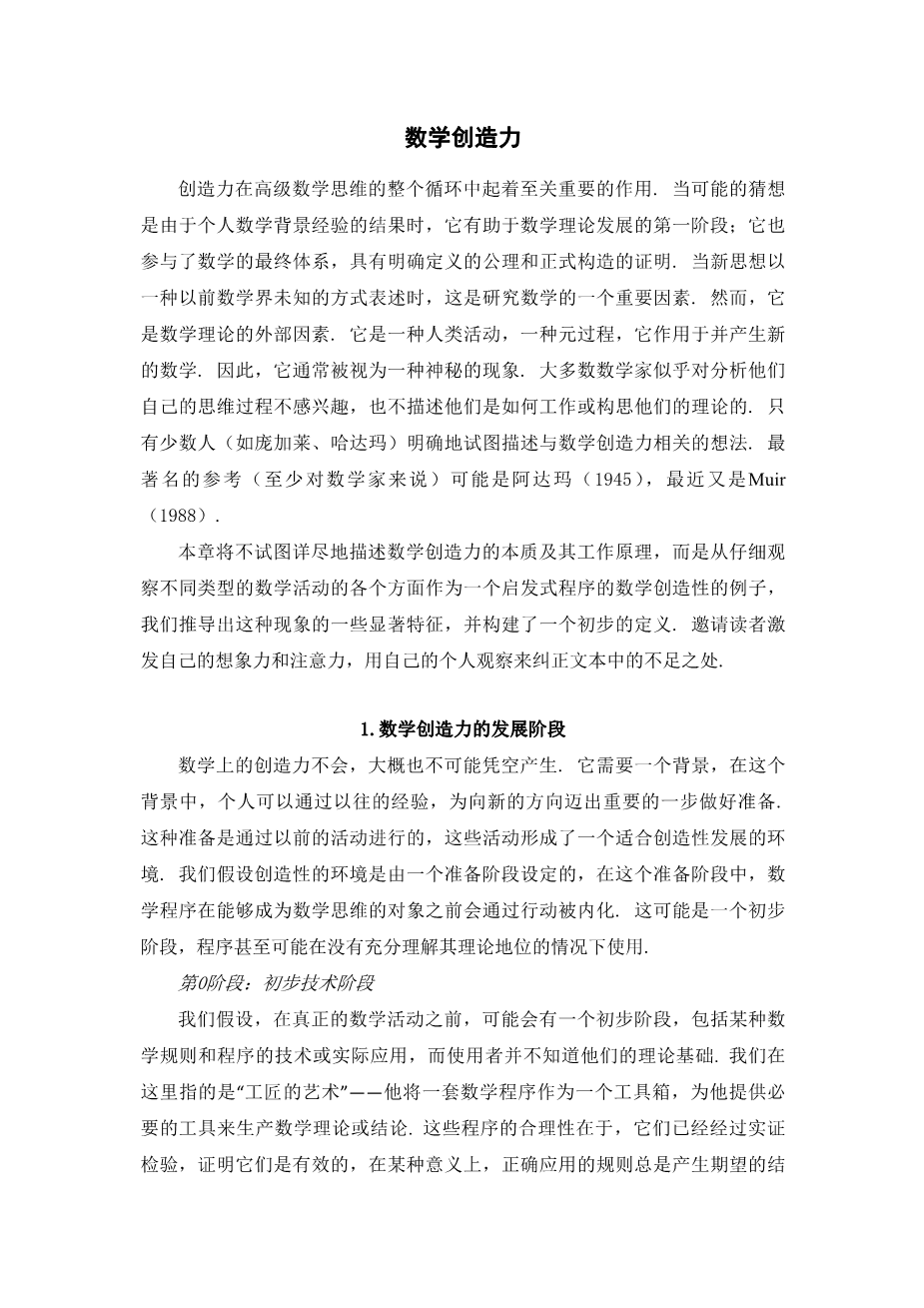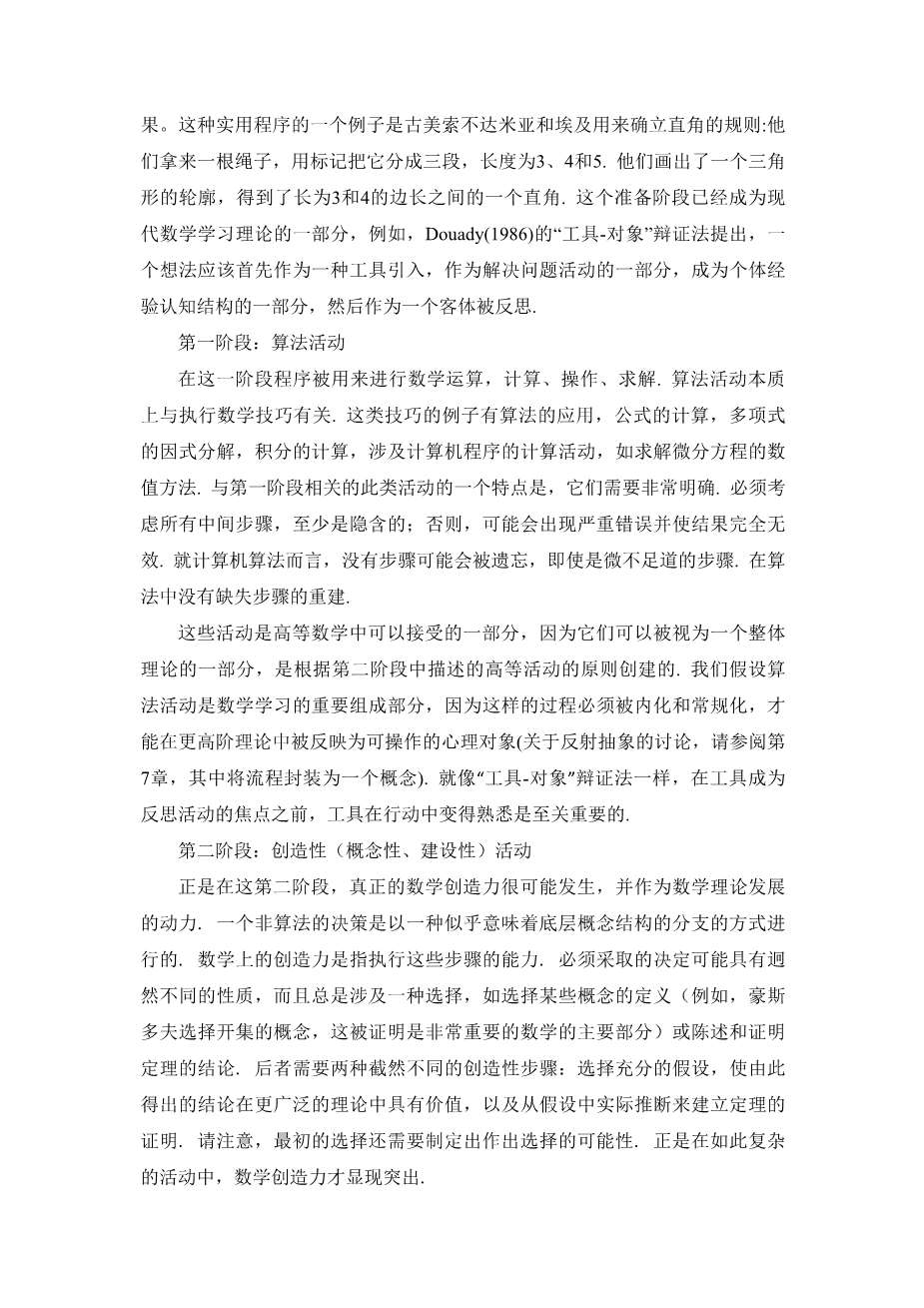Mathematical Creativity
Creativity plays a vital role in the full cycle of advanced mathematical thinking. It contributes in the first stages of development of a mathematical theory when possible conjectures are framed as a result of the individualrsquo;s experience of the mathematical context; it is also plays a part in the formulation of the final edifice of mathematics as a deductive system with clearly defined axioms and formally constructed proofs. It is an essential factor in research mathematics when new ideas are formulated in a manner previously unknown to the mathematical community. Yet it is external to the theory of mathematics. It is a human activity, a meta-process, which acts upon and generates new mathematics. As such it is often viewed as a mysterious phenomenon. Most mathematicians seem to be not interested in the analysis of their own thinking procedures and do not describe how they work or conceive their theories. Only a few (such as Poincareacute;, Hadamard) explicitly attempt to describe ideas related to mathematical creativity. The best known reference (at least to mathematicians) is probably Hadamard (1945), which has been followed recently by Muir (1988).
The present chapter will not attempt to give an exhaustive description of the nature of mathematical creativity and how it works. From a somewhat closer look at the aspects of different kinds of mathematical activity as an heuristic procedure to register examples of mathematical creativity, we derive some striking characteristics of the phenomenon and frame a tentative definition. The reader is invited to activate his/her own imagination and attentiveness and to rectify deficiencies in the text with their own personal observations.
1. The Stages of Development of Mathematical Creativity
Mathematical creativity does not, presumably cannot, occur in a vacuum. It needs a context in which the individual is prepared by previous experiences for the significant step forward in a new direction. Such preparation occurs through previous activities which form an appropriate environment for creative development. We hypothesize that the context for creativity is set by a preparatory stage in which mathematical procedures become interiorized through action before they can be the objects of mathematical thought. Preliminary to this may be an initial stage where the procedures might be used without even a full appreciation as to their theoretical status.
Stage 0: A preliminary technical stage
We hypothesize that genuine mathematical activity may be preceded by a preliminary stage consisting of some kind of technical or practical application of mathematical rules and procedures, without the user having any awareness of their theoretical foundation. We refer here to the art of the craftsman who applies a set of mathematical procedures as a toolkit providing him with the necessary tools to manufacture his product. The justification for these procedures is that it has been checked empirically that they work, in the sense that a correctly applied rule always yields the desired result. An example of such a practical procedure is the rule used in Ancient Mesopotamia and Egypt to stake out a right angle: they used a rope with marks dividing it into three parts of length 3, 4 and 5. Forming the contour of a triangle, they obtained a right angle between the sides of length 3 and 4. This preparatory stage has become part of modem theories of mathematics learning, for instance, the “tool- object” dialectic of Douady (1986) which proposes that an idea should be introduced first as a tool as part of a problem-solving activity, to become part of the individualrsquo;s experiential cognitive structure before being reflected on as an object in its own right.
Stage I : Algorithmic activity
At this stage procedures are used to carry out mathematical operations, to calculate, manipulate, solve. Algorithmic activity is essentially concerned with performing mathematical techniques. Examples of such techniques are: application of an algorithm, working out formulae, factorizing a polynomial, calculating an integral, computational activities involving computer programs such as in numerical methods for solving differential equations. A characteristic of such activities pertaining to this first stage is that they need to be quite explicit. All intermediate steps have to be considered, at least implicitly; if not, a serious error may occur and totally invalidate the result. In the case of a computer algorithm, no steps, not even trivial ones, may be forgotten. There is no regeneration of missing steps in an algorithm.
Such activities are an acceptable part of advanced mathematics because they may be seen as part of an overall theory, created in accordance with the principles of the higher activities to be described in stage 2. We hypothesize that algorithmic activity is an essential part of the learning of mathematics because such processes must be interiorized and become routinized before they can be reflected upon as manipulable mental objects in a higher order theory. (See chapter 7 for a discussion of reflective abstraction, in which a process is encapsulated as a concept). As with the tool-object dialectic, it is essential that the tool become familiar in action before it becomes the focus of reflective activity.
Stage 2: The creative (conceptual, constructive) activity
It is at this second stage that true mathematical creativity is likely to occur and act as a motive power in the development of a mathematical theory. A non-algorithmic decision is taken in a manner which seems to signify a bifurcation of the underlying concept structure. Mathematical creativity is the ability to perform such steps. The decisions that have to be taken may be of a widely divergent nature and always involve a choice, such as a choice of a certain concept to b
剩余内容已隐藏,支付完成后下载完整资料


英语译文共 7 页,剩余内容已隐藏,支付完成后下载完整资料
资料编号:[588254],资料为PDF文档或Word文档,PDF文档可免费转换为Word
您可能感兴趣的文章
- 饮用水微生物群:一个全面的时空研究,以监测巴黎供水系统的水质外文翻译资料
- 步进电机控制和摩擦模型对复杂机械系统精确定位的影响外文翻译资料
- 具有温湿度控制的开式阴极PEM燃料电池性能的提升外文翻译资料
- 警报定时系统对驾驶员行为的影响:调查驾驶员信任的差异以及根据警报定时对警报的响应外文翻译资料
- 门禁系统的零知识认证解决方案外文翻译资料
- 车辆废气及室外环境中悬浮微粒中有机磷的含量—-个案研究外文翻译资料
- ZigBee协议对城市风力涡轮机的无线监控: 支持应用软件和传感器模块外文翻译资料
- ZigBee系统在医疗保健中提供位置信息和传感器数据传输的方案外文翻译资料
- 基于PLC的模糊控制器在污水处理系统中的应用外文翻译资料
- 光伏并联最大功率点跟踪系统独立应用程序外文翻译资料



